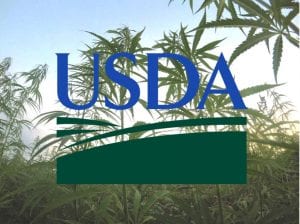USDA Issues Interim Final Hemp Production Regulations
November 12, 2019
By Lauren Mendelsohn, Esq.

On October 31, 2019 the United States Department of Agriculture (USDA) Agricultural Marketing Service (AMS) published an Interim Final Rule for hemp production under the 2018 Farm Bill. We previously discussed the 2018 Farm Bill here.
The Interim Final Rule outlines the process for the USDA to approve hemp production plans submitted by States and Indian Tribes, as well as for a federal hemp production program that would apply in States and Indian Tribes which have not submitted their own plans. It touches on the procedures for sampling, testing, and (if necessary) destruction of hemp crops as well as the licensing process and requirements for hemp producer licenses, among other things. The rule is “final” in that it went into effect immediately, but “interim” in that the USDA is soliciting public comments and might change certain components of the rule.
You can view the USDA’s Interim Final Rule on Hemp Production on the Federal Register Website here. Comments must be received by December 30, 2019. You can submit a formal comment by clicking here.
Some key points we wanted to highlight include:
- States and Indian Tribes can now submit hemp production plans to the USDA, and the USDA has 60 days from the time of submission to approve or deny a particular State or Tribal plan. Applications for Federal hemp production licenses will not be accepted by USDA until December 2, 2019 to provide States and Indian Tribes with time to submit their plans.
- Laboratories testing hemp must be registered with the DEA. This requirement may lead to a shortage of qualified labs.
- THC content must be calculated via “total THC,” which includes THC as well as THCA rather than simply delta-9-THC. This could lead to more hemp testing “hot” and will likely force growers to harvest before the plant has accumulated a desirable amount of CBD in order to avoid having too much THC and THCA.
- When sampling, only the very top of the plant is to be sampled, which is where cannabinoid content is the highest. However, the definition of “hemp” under the farm bill includes all parts of the cannabis plant with a THC content of 0.3% or less. Thus, there may be an argument that USDA exceeded their authority by requiring that sample cuttings be made just underneath the flower material.
- Rather than following the traditional “Notice and Comment Period” typically used by agencies before promulgating rules, the USDA jumped straight to issuing an “Interim Final Rule” and is taking public comments now. USDA argues that the normal notice and comment period would have been “impracticable, unnecessary, or contrary to the public interest,” but that is debatable. Thus, there is an argument that USDA didn’t comply with the Administrative Procedures Act (APA).
- The rule requires that harvest occur within 15 days of sampling. This could be infeasible due to the fact that lab results may not arrive for several days after sampling occurs, leaving hemp producers with very little time to harvest acres.
- There are penalties for “hot hemp,” meaning hemp that tests at more than 0.3% total THC. Producers who take reasonable efforts to keep the total hemp content at 0.3% or less and whose hemp tests at a total THC content of no more than 0.5% will not be deemed negligent. However, hemp that tests above 0.5% will be deemed a negligent violation, and a Notice of Violation that includes a corrective action plan will be sent to the producer. Three negligent violations within five years results in suspension. There are penalties for other violations as well, such as for producing hemp without a license.
- Negligent violations will not result in criminal enforcement, though they can lead to suspension or revocation of a producer’s license and may also be reported to the Attorney General. Intentional violations can also lead to suspension, revocation, or other penalties and must be reported to the Attorney General and the chief law enforcement officer of the State or Indian Tribe where the violation occurred.
- Hemp that tests above the allowable amount must be destroyed, and cannot be remediated. However, a hemp producer can request that the lab test be re-conducted if they believe the original THC concentration results were in error.
- The 2018 Farm Bill included a felony ban that is reiterated in the Interim Final Rules. Specifically, a person with a State or Federal felony conviction relating to a controlled substance is subject to a 10-year ineligibility restriction on producing hemp, though an exception applies to a person who was lawfully growing hemp under the 2014 Farm Bill before December 20, 2018, and whose conviction also occurred before that date.
These are just a few components of the Interim Final Rule that we wanted to highlight — we encourage you to read the rule and these FAQs for more information. More analysis from our office is forthcoming.
Additional Resources
- List of submitted state hemp production plans
- Testing Guidelines for Hemp
- Sampling Guidelines for Hemp
- Laboratory Test Results Report Form
- Crop Acreage Reporting Information
- State and Tribal Plan Requirements
- State and Tribal Hemp Producer Report
- State and Tribal Hemp Disposal Report
- State and Tribal Hemp Annual Report
This information is provided as an educational public service and is not intended as legal advice. For specific legal questions regarding hemp, please contact the Law Offices of Omar Figueroa at (707) 829-0215 or info@omarfigueroa.com to schedule a confidential consultation.
